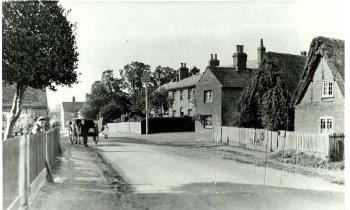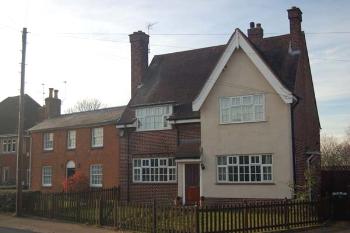The Red Lion Public House Ridgmont

Red Lion and High Street about 1900
The Red Lion Public House: 77 High Street, Ridgmont
For most of the nineteenth and twentieth centuries Ridgmont had three public houses along the High Street - the Rose & Crown, The Red Lion and the White Hart. The Red Lion was in the centre of the village and the earliest reference to it in any document held by Bedfordshire & Luton Archives & Records Service is in a Directory of 1847 when the licensee was a John Barber. The public house does not appear in the licensing records for 1822-1828 held in the archive [CLP13], thus it must have opened some time between 1829 and 1847.
John Barber was the owner of the public house and, on his death in 1869 it was sold at auction, along with the neighbouring cottage, another house, an acre of market gardening land, and two further cottages each divided into two tenements. The Red Lion was described as an old established public house containing a taproom, living room, small bar, parlour, kitchen and shop, a cellar and five bedrooms. It had a yard with a number of buildings including a larder, coal shed, gig house, stable, wood barns, workshop and piggeries. It was noted "This Lot stands well for Business, is doing an excellent Trade and was in the Occupation of the Deceased…up to the time of his Death" [SF51/19].
The Biggleswade brewers Wells & Company (a totally separate company from the later Bedford firm of Charles Wells) purchased the property. Wells & Company was purchased by Kent businessman George Winch for his son Edward Bluett Winch in 1899 and in 1961 Wells & Winch merged with Suffolk brewers Greene King. The public house remained a Greene King house until it closed in 2004. The former public house is now a private house.

former Red Lion in February 2007
The Rating and Valuation Act 1925 specified that every building and piece of land in the country was to be assessed to determine its rateable value. The Red Lion was valued in 1927[DV1/C54/89] - the valuer noted that the tenant was an Assistant Overseer of the Poor for the parish, he was a "good, well-known tenant" and trade was "largely personal" but did include the Cyclists' Touring Club. Perhaps business was helped by the fact that outside the public house was a bus stop. Takings were estimated at £550 per annum for 60 barrels of beer and 15 gallons of spirits; strangely one of the valuer's notes simply reads "Gorgonzola Cheese"!
Once he had eaten the afore-mentioned cheese the valuer noted that the premises consisted of a brick and slate detached building with a bar ("small"), bar cupboard, tap room ("small"), kitchen, reception room and cellar below with four bedrooms and a box room above. Outside the premises comprised a stable, barn, coal shed, wc and cesspool.
References:
- PSW3/1: Register of Alehouse Licences - Woburn Petty Sessional Division: 1868-1949;
- SF51/19: auction sale of Red Lion and adjoining premises and land by executors of John Barber: 1869;
- GK28/1: conveyance to Wells & Company: 1869;
- GK1/36: in a sale catalogue: 1898;
- Z1039/34/2: conveyed, with others, to Wells & Winch: 1899;
- X347/121: photograph taken from top of Lydds Hill: early C20;
- X347/124: photograph of High Street showing Red Lion and Rose & Crown: early C20;
- X347/125: photograph of High Street looking towards Red Lion: 1901;
- Z50/95/47: photograph: C20;
- Pamp160: Bedfordshire Inns & Pubs on Old Picture Postcards by Sandy Chrystal: c.1906;
- Z49/913: photograph of inn sign: c.1910;
- PSA5/2: Register of Alehouse Licences - Ampthill Petty Sessional Division: 1934-1959;
- PSW3/2: Register of Alehouse Licences - Woburn Petty Sessional Division: 1949-1953;
- PSA5/5: Register of Licences - Ampthill Petty Sessional Division: 1968-1995
List of Licensees: note that this is not a complete list. Italics indicate licensees whose beginning and/or end dates are not known:
1847-1869: John Barber;
1869: Clarke Barber;
1877-1885: John Inns;
1885-1892: John Weston;
1892: George Pepper;
1892-1893: Alfred Smith;
1893-1898: Thomas Sinfield;
1898-1901: Alfred Leaper;
1901-1904: John Chapman;
1904-1905: Mark Parrott;
1905: Oliver Henry Billing;
1905: James Bloomfield Northcott;
1905-1906: Archie Rasner;
1906-1908: Ernest James Thorne;
1908-1909: Sydney William Pearse;
1909-1910: Frank Marchant;
1910-1911: John Chapman;
1911-1912: Emma Chapman;
1912-1914: Charles House;
1914-1915: Dealtry Hamilton;
1915-1919: Alfred Faulkner;
1919-1922: Harry Samuel Nicholls;
1922-1923: Arthur Gibbons;
1923-1940: William Harry Newman;
1940-1954: William Ernest Hawkins;
1954-1959: John Sturgess Arnott;
1959: Henry James Bazzone;
1966-1971: Patrick Timothy O'Callaghan;
1971-1973: Melvyn Stanley Hewitt;
1973-1976: Dennis John Foster;
1976-1981: John Alfred Wigglesworth;
1981-1982: Trevor Anthony Deacon;
1982-1985: Stewart John Williams;
1985-1986: Robert Derek Simpkins;
1986-1994: Raymond Edward Harris;
1994: Alan Charles Birkbeck
Public House closed around 2004